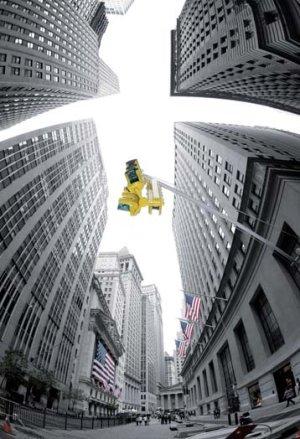Economy: America is Not Japan

By Jesper Koll
The re-regulation and nationalization of the US banking system is a far cry from the dark days here following the bubble era.
There are significant differences between Japan’s banking crisis in the 1990s and the US crisis today. In fact, it is highly likely US banks will be much worse off after all the public policy intervention and crisis management, while Japanese banks were turned from being bad banks into being good ones.
At the outset, let me make sure you understand that I am not talking about the bad balance sheets and capital shortage in the financial system. Here the Japan and US crises are very similar: A reckless credit boom is followed by a bust, public capital is injected to allow the write-offs and then, eventually, a new cycle starts. The problem is that for Japan, public policy was very focused on ensuring that a new cycle would start, that the banks could actually be turned into better ones. In contrast, current US policy leaves little hope that American banks will ever again be as profitable as they were in the past. Why? Japan’s counter policy was to deregulate and privatize while current US policy is to re-regulate and nationalize.
Some specifics: Japanese banks were bad banks throughout the boom of the 1980s. Yes, they built huge balance sheets by lending recklessly to real estate speculators and buying US trophy assets like Rockefeller Center, but their operating business was barely profitable, with wafer-thin margins, high costs and a powerful straightjacket of rules and regulations that prevented them from doing basically anything outside the bare-bone deposit and loan business. Even at the heyday of Japan’s bubble economy in the late 1980s, non-interest income was not even 5 percent of total income. In other words, outside the traditional banking business of making money from collecting deposits and lending at higher interest rates, Japanese banks had not much of a business.
 Japan’s post-bubble rebuilding of its banking system cannot be used as a blueprint for the US.
Japan’s post-bubble rebuilding of its banking system cannot be used as a blueprint for the US.
Japan’s ‘Big Bang’ of the mid-1990s started to change that, laying out a clear time schedule for when banks could start new business like selling mutual funds and insurance. Today, non-interest income is almost one-third of all income for Japanese banks. The deregulation drive of the 1990s allowed banks to built new profit centers after their balance sheets were fixed.
In contrast, US banks already exploited all the benefits of deregulation before their balance sheets went bad. Non-interest income accounted for almost half of their total income just last year, before the crisis hit. US policy is now focusing on tighter rules, more regulation, all of which will mean that future profit opportunities for US banks are being cut back. On top of bad balance sheets, US banks have a bad business outlook as their industry is going to be squeezed. In contrast, Japan banks, yes, had bad balance sheets, but while these were supported with public funds, public policy actually focused on allowing banks to build new profit centers. Specifically, non-interest income now makes up almost one third of total income as banks have thrived from deregulation opportunities.
Moreover, the positive impact of postal savings privatization should not be underestimated. By the mid-1990s, the public postal banks and postal insurance accounted for almost 80 percent of all financial intermediation. In plain speak, the public sector bank saw most of the follow-through from savings to investment, which means the private banks were ‘crowded out,’ meaning they were not able to profit from the basic financial flow in the economy. With the ‘Big Bang,’ the public postal bank gradually moved out of the way. For example, the postal bank-funded housing and loan corporation stopped making mortgage loans and private banks were allowed to pick up that business. This created huge ‘crowding in’—new profit opportunities for the private sector. The latest housing and construction boom was almost entirely funded by private banks, accounting for almost half of the growth in their operating profitability.
All said, Japan’s banks were bad banks with very low profitability and the 1990s deregulation and privatization drive allowed them to build new, profitable businesses. US banks were very good banks with record profitability and super high returns. Now re-regulation and nationalization is poised to cap their earnings’ up-side potential. No doubt, this is necessary after the excesses caused by the horrific lack of supervision and public and private governance in financial America over the past decade. But if stock markets are seeking to discount future earnings streams, a Wall Street recovery will not start with public bailouts and capital injections, but will only start when credible rules and established supervision are that allows US banks to build new profit centers. Where Japan offered public capital and a business plan, the US, right now, is only offering capital but no plan for future growth.
Jesper Koll is the CEO of independent investment advisory company, Tantallon Research Japan.






Comments
Anonymous (not verified)
March 13, 2011 - 07:18
Permalink
Typical CEO Rhetoric
Jesper Koll, author of this article, is a CEO of an investment company.
He should know then that whenever banks make quick, sharp increases in their profits that it means bad news for, well, everyone else. At least, Koll should know this. Then again, businessmen rarely study history. He's equated the success of a few large banks with the well-being of an entire economy, which is quite frankly not true.
Don't forget that JP Morgan and other banking big-wigs made a KILLING as they triggered the Great Depression in the early 1900s. There's a reason we had so many regulations on banks and financial institutions (until the 1980s). When we speak of re-regulating banks, we aren't applying any new rules. We're simply reestablishing the rules that were removed -- by the banks and their lobbies!